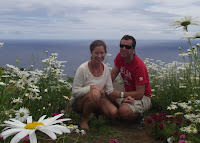Position: 38°32’N, 28°37’W – Horta, Azores
After finding our feet in Flores we hired a car and explored the most westerly of the Azores islands. The island is aptly named for its abundance of colourful flowers which decorate the rugged, natural landscape and take the edge off the windswept cliffs that drop off sharply into the Atlantic.

Craters of the island’s seven original volcanoes have now become seven beautiful lakes which are home to many birds and plants found only in the Azores. We drove through quiet, quaint villages and revelled in the sights of white-washed, orange-roofed cottages sitting pretty in lush green valleys. For a moment, we thought we had got ahead of ourselves and were already in the west of Ireland!
We sailed for two days to the island of Faial and the port of Horta. Since its first inhabitants arrived by ship 500 years ago, Horta has leveraged its strategic location between North America and Europe to become the sailing headquarters/centre of the Atlantic. Every year over 1,000 boats stop here on their way across the Atlantic to Europe, touring the islands, topping up on provisions and relaxing over Gin Tonicos at the famous Peter Cafe Sport.
With Ashling safely anchored in the sheltered harbour, we rented bikes to see some of the island and hike around the crater of the extinct Caldeira do Faial volcano. The greenery, the silence, the natural beauty untouched by man were breathtaking ... especially when we were freewheeling down the side of the volcano at 50 km/hr.

Four miles across the bay from Horta is the island of Pico, home of Portugal's highest mountain which we visited by ferry and bus. The island reminded us a lot of Rangitoto in Auckland, with its perfect symmetrical cone-shaped volcano and harsh, black rocky landscape. However while Rangitoto prides itself on conservation and tourism, the people of Pico have found a way to make money from their volcano.
On the west of the island the locals have cleared away the black lava rocks and used them to build walls. Where possible, the cracks in the remaining rock surface are filled with soil from neighbouring Faial and used to plant vines. The small, short walls shelter the vines from the wind and sea-breezes, and enable a thriving wine-making industry, some of which has apparently graced the table of a Russian Tsar in years past.

We love it here! The Azores have been the first place on our journey where we have automatically felt at home, despite knowing absolutely nothing of the language. It may have something to do with the Ireland/New Zealand-esque topography (they have pohutakawa trees here too!) or the ease of navigating life on a small island. While each island has its own unique personality, they all share the same admirable pride that comes with surviving in isolation and using whatever nature provides to be self-sufficient. With six other islands to explore, we aren’t at all ready to leave and yet, Ireland is calling. One thing is for sure – by plane or by boat, we will be back!
P.S. The Skipper has uploaded a map of our daily
positions since leaving Auckland last September. Check out the link on the
right hand side of the blog or click here to see it.




Love your posts guys. BTW how's Ashling doing? Doing OK across the Atlantic?
ReplyDeletePS: Love the 'map-my-trip' type thing :-)
Guys, knew very little about the Azores, thanks for such a great insight, love the pics. what is your ETA for Ireland???
ReplyDelete